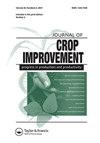热干旱胁迫下玉米群体产量和次生性状的QTL和基因组预测准确性
IF 1.5
Q3 AGRONOMY
引用次数: 0
摘要
摘要:高温和干旱胁迫对玉米产量产生负面影响。我们的目的是确定对热胁迫(HS)和热干旱联合胁迫(HS+DS)的耐受性的遗传基础,并比较如何利用QTL和全基因组选择(GS)来提高对这两种胁迫的耐受性。2014年、2015年和2016年夏季,在墨西哥索诺拉州奥夫雷贡市,在HS和HS+DS条件下,对来自玉米双亲双单倍体群体的97个试验杂交种进行了评估。在HS和HS+DS条件下,粮食产量分别达到5.7和3.0 t ha−1。在6个环境中检测到26个QTL,LOD得分在2.03至3.86之间;QTL解释了8.6%-18.6%的表型变异。HS(r=0.97)和HS+DS(r=0.74)的高光谱生物量和结构指数(HBSI)与GY的遗传相关性高于与作物水分或绿色指数的相关性。HS(r=-0.89)和HS+DS(r=-0.75)或植被指数的GY与冠层温度之间的遗传相关性,以及1.02、1.05和2.05中的QTL聚类,强调了这些基因组区域对与一般活力和绿色相关的次要性状的重要性。用于GS的模型的预测精度低于先前研究中发现的值。我们发现了一个对HS和HS+DS具有耐受性的高产杂交种。本文章由计算机程序翻译,如有差异,请以英文原文为准。
QTL and genomic prediction accuracy for grain yield and secondary traits in a maize population under heat and heat-drought stresses
ABSTRACT Heat and drought stresses negatively affect maize (Zea mays L.) productivity. We aimed to identify the genetic basis of tolerance to heat stress (HS) and combined heat and drought stress (HS+DS) and compare how QTL and whole genome selection (GS) could be leveraged to improve tolerance to both stresses. A set of 97 testcross hybrids derived from a maize bi-parental doubled-haploid population was evaluated during the summer seasons of 2014, 2015, and 2016 in Ciudad Obregon, Sonora, Mexico, under HS and HS+DS. Grain yield (GY) reached 5.7 t ha−1 under HS and 3.0 t ha−1 under HS+DS. Twenty-six QTL were detected across six environments, with LOD scores ranging from 2.03 to 3.86; the QTL explained 8.6% to 18.6% of the observed phenotypic variation. Hyperspectral biomass and structural index (HBSI) had higher genetic correlation with GY for HS (r = 0.97) and HS+DS (r = 0.74), relative to the correlation with crop water mass or greenness indices. Genetic correlations between GY and canopy temperature for HS (r = −0.89) and HS+DS (r = −0.75) or vegetation indices, along with clusters of QTL in bins 1.02, 1.05, and 2.05, underline the importance of these genomic areas for secondary traits associated with general vigor and greenness. Prediction accuracy of the model used for GS had values below those found in previous studies. We found a high-yielding hybrid that was tolerant to HS and HS+DS.
求助全文
通过发布文献求助,成功后即可免费获取论文全文。
去求助
来源期刊

Journal of Crop Improvement
Multiple-
CiteScore
3.30
自引率
7.70%
发文量
42
期刊介绍:
Journal of Crop Science and Biotechnology (JCSB) is a peer-reviewed international journal published four times a year. JCSB publishes novel and advanced original research articles on topics related to the production science of field crops and resource plants, including cropping systems, sustainable agriculture, environmental change, post-harvest management, biodiversity, crop improvement, and recent advances in physiology and molecular biology. Also covered are related subjects in a wide range of sciences such as the ecological and physiological aspects of crop production and genetic, breeding, and biotechnological approaches for crop improvement.
 求助内容:
求助内容: 应助结果提醒方式:
应助结果提醒方式:


